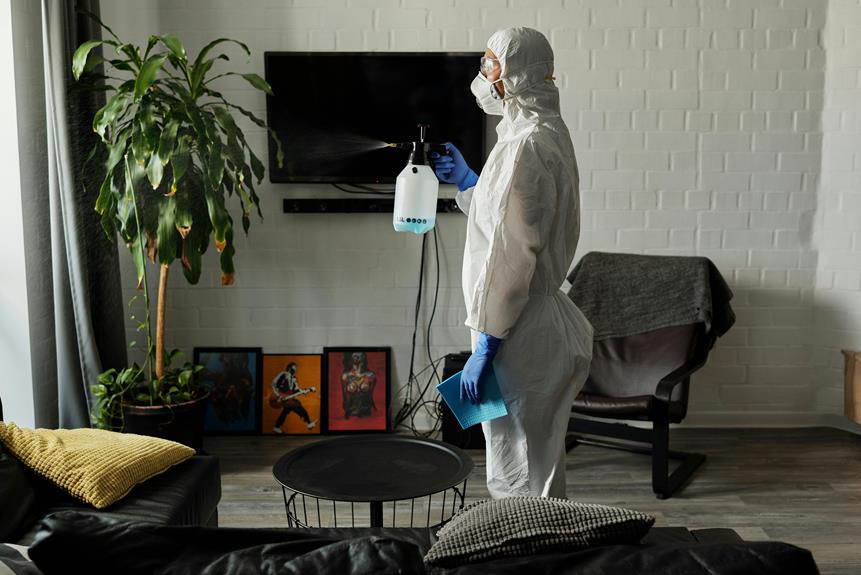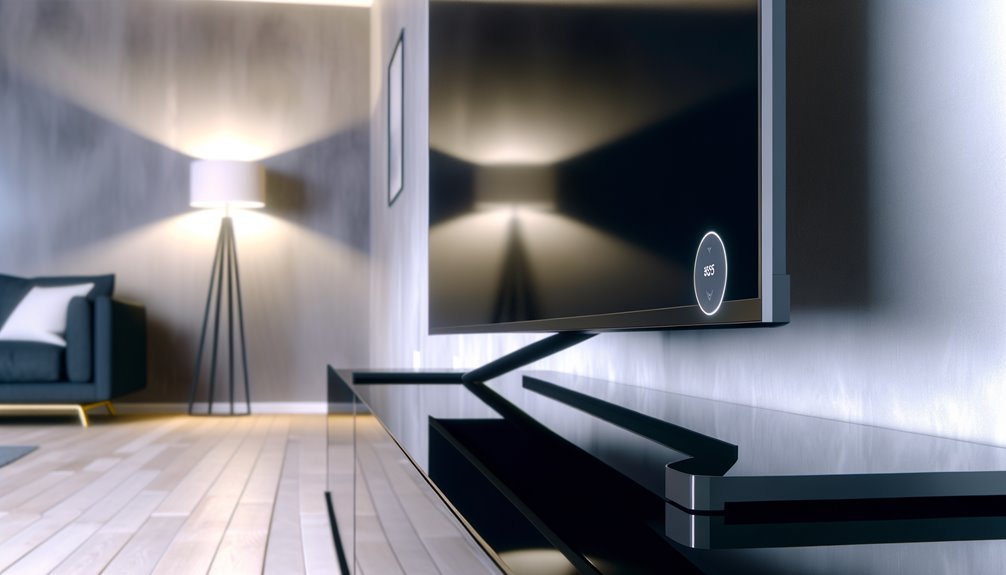You can mount a TV above a radiator, but you need to take precautions to avoid damage. Keep at least 6 inches between the TV and radiator to prevent overheating.
Use a full-motion TV wall bracket for better positioning. Install a heat shield or floating shelf to deflect rising heat, and consider a radiator cover for added protection.
Make sure to organise cables using insulation tunnels and clips to keep them safe from heat transfer.
Regularly monitor both your TV and radiator temperatures to guarantee safe operation.
To maximise the lifespan and performance of your TV, consider these measures.
Key Information
- Maintain a minimum distance of 6 inches between the TV and radiator.
- Use a heat shield or floating shelf to deflect heat away from the TV.
- Ensure proper ventilation to prevent damage to sensitive electronics.
- Regularly monitor temperatures to prevent overheating and ensure TV longevity.
- If you require TV wall mounting, simply click the “Book Now” button and follow the steps to secure your appointment.
Understanding Radiator Functionality
Radiators operate by heating water that circulates through their fins, effectively transferring heat to the surrounding air via convection. This process guarantees efficient and even heating throughout your home.
Modern insulation techniques allow you to place radiators flexibly for ideal heat distribution, maximising comfort and energy efficiency.
However, you need to be cautious with the placement of sensitive electronic devices like TVs. The rising heat from a radiator can damage your TV, causing dead pixels, electrical faults, and ultimately reducing its lifespan.
To avoid these issues, make sure there’s proper ventilation and maintain a safe distance between your radiator and TV.
Understanding these dynamics helps you balance effective heating with the longevity of your electronics.
Risks of Heat Exposure
Understanding the delicate balance between effective heating and the longevity of your electronics requires a closer look at the risks of heat exposure. Placing a TV above a radiator poses several potential hazards:
- Metal Component Damage: High temperatures can warp or damage the metal components inside your TV, leading to malfunction.
- Internal Structure Melting: Prolonged exposure to heat can cause internal structures to melt, resulting in irreversible internal damage.
- Electrical Faults and Fire Hazards: Heat increases the risk of electrical faults, which could potentially lead to dangerous fire hazards.
Additionally, heat exposure can desaturate images, causing a noticeable loss of colour quality.
Ensuring proper spacing between the TV and radiator is vital to prevent these issues and maintain your TV’s performance.
Safe Mounting Techniques
To safely mount your TV above a radiator, make sure you maintain a minimum distance of 6 inches between the two to mitigate overheating risks.
Use a full-motion TV wall bracket to easily adjust the TV’s position, optimising both viewing angles and heat management.
Installing a heat shield or a floating shelf can deflect rising heat away from your TV, prolonging its lifespan.
Always consult your TV’s manual for the recommended operating temperatures to guarantee safe placement near a radiator.
A radiator cover is another practical solution, protecting your TV from excessive heat exposure while still allowing efficient heating in your room.
These techniques help you enjoy your TV without compromising its performance or longevity.
Additional Protective Measures
In addition to safe mounting techniques, employing additional protective measures can further safeguard your TV from heat damage when positioned above a radiator.
Consider using a heat shield to deflect heat away from the TV. Installing a floating shelf above the radiator can also help create a safe distance.
Regularly monitoring the temperature of both the TV and the radiator guarantees safe operation.
Here are three essential steps you can take:
- Install a heat shield or barrier: This deflects heat away from the TV.
- Use a floating shelf: It creates a buffer zone and prevents direct heat exposure.
- Regular temperature checks: Consistently monitor temperatures to avoid overheating.
These measures are vital for maintaining the longevity and functionality of your TV.
Cable Management Strategies
Properly managing your cables is essential to ensuring the safety and performance of your TV when mounted above a radiator. Use insulation tunnels to protect cables from the radiator’s heat, preventing overheating and potential damage.
Employ cable clips or ties to keep wires organised and maintain a safe distance from the radiator. Ensure cables don’t drape over or touch the radiator to avoid heat transfer.
Implementing these techniques not only safeguards your TV but also enhances its operational efficiency.
Remember, effective cable management is vital for safety, so take the time to arrange and secure your cables properly, ensuring they stay cool and function optimally.
Alos see our article : How to Hide Wires From Mounted TV Without Cutting Wall
Optimal TV Placement
When placing your TV above a radiator, maintaining a minimum clearance of 6 inches is essential to prevent overheating and guarantee peak performance. To secure ideal TV placement, consider the following:
- Use a wall mount or floating shelf: These can deflect rising heat, protecting your TV from thermal damage.
- Reference the TV manual: Check for recommended operating temperatures to secure your TV’s safety.
- Install a thermostatic valve: This helps control the radiator’s heat output, reducing the risk of overheating the TV.
Additionally, always factor in the size and heat output of your radiator. Larger radiators or those with higher heat output may require greater distances for safe TV placement.
By following these steps, you can enjoy safe and efficient TV viewing.
Frequently Asked Questions
Can I Put My TV on the Wall Above a Radiator?
Yes, you can, but it’s risky. Excess heat from the radiator can damage your TV’s electronics. Use a heat shield or maintain a sufficient gap. Regularly monitor temperatures to guarantee the TV’s performance and lifespan aren’t compromised.
How Close Can a TV Be to a Radiator?
You should place your TV at least 6 inches away from a radiator. This spacing prevents heat damage and overheating. Adjust the distance based on radiator size, heat output, and TV model specifics for best protection.
What Can You Put Above a Radiator?
You can place a shelf above a radiator to deflect heat, use radiator covers as a barrier, or install a wall-mounted unit to create distance. Guarantee proper ventilation and consider heat shields for additional protection.
Is It Okay to Put a Sofa in Front of a Radiator?
It’s not advisable to put a sofa in front of a radiator. Doing so blocks heat distribution, reduces heating efficiency, and increases energy consumption. For best performance, maintain clear space around your radiator for better air circulation.
Conclusion
To safely mount a TV above a radiator, you need to understand the heat risks and take protective measures. Use a heat shield or shelf to divert heat, ensuring your TV’s longevity.
Implement proper cable management to prevent overheating and optimise your setup.
By following these guidelines, you can achieve a functional and aesthetically pleasing TV placement without compromising the performance of either your radiator or television.
If you require TV wall mounting, simply click the “Book Now” button and follow the steps to secure your appointment.



